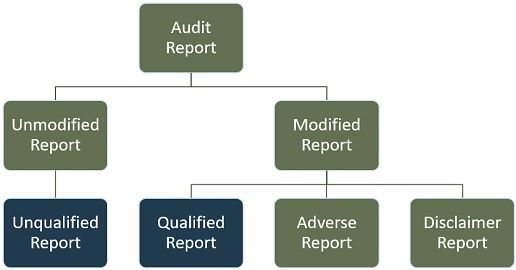 When the auditor is completely satisfied with the truth and fairness of the financial statements of the company’s accounts not have any qualifications, i.e. negative statements. Such a report is called an unqualified or clean report.
When the auditor is completely satisfied with the truth and fairness of the financial statements of the company’s accounts not have any qualifications, i.e. negative statements. Such a report is called an unqualified or clean report.
Contrarily, there are instances when the auditor qualifies the audit report, when the company’s financial records are not kept as per the generally accepted accounting principles, however, no misrepresentations are found. In such a case, the report issued by the auditor is a qualified report.
What is an Audit Report?
After the completion of the Audit, an audit report is generated by the auditor. It comprises factual information and the opinion of the auditor on the financial statement. It acts as a means of communication of the auditor’s views to the company’s members about the financial statements after considering the audit evidence received.
An audit report can be of four types:
- Unqualified Report
- Qualified Report
- Adverse Report
- Disclaimer Report
This content presents all the differences between unqualified and qualified audit reports.
Content: Unqualified Vs Qualified Report
- Comparison Chart
- Definition
- Key Differences
- When an Auditor issues an Unqualified Report?
- Conclusion
Comparison Chart
| Basis for Comparison | Unqualified Report | Qualified Report |
|---|---|---|
| Meaning | Audit Report is said to be clean or unqualified when there is no qualifications in the report. | Audit Report is considered as qualified report when auditor expresses an opinion in the report. |
| Form of | Unmodified Report | Modified Report |
| Material Misstatements | The report is free from any material misstatements. | Misstatements are material but not pervasive. |
| Reflects | It reflects that the auditor is satisfied with the points that must be expressed in his report and that too in a positive sense, without any reservations. | It reflects that there is a limitation on the scope of audit or failure of the auditee to follow GAAP. |
| Reservations | No | Yes |
| Issued when | Organization's financial position, status and operations are presented in a true and fair manner. | Organization's financial position status and operations are presented in a true and fair manner but with a certain exceptions. |
| Management's Duty | No specific duty of management | Management is obligated to provide explanations and complete details with regard to each qualification given in the audit report. |
Definition of Unqualified Report
An unqualified report is a report in which the auditor concludes that the company’s financial position represents a true and fair view of the financial position, and the profit or loss for the period not having any reservations. It is also called the clean report, which is free from any qualifications. It is issued when the auditor is satisfied with the matters like:
- He has obtained all the reasonable evidence that backs various relevant transactions.
- All entries have been made as per generally accepted accounting principles.
- Financial statements of the company are in line with the company’s books of accounts
- All material facts and information have been disclosed.
Such a report is free from any material misstatements and presents that the financial statements are prepared as per the accounting principles. It indicates that the auditor is satisfied with the points required to be stated in the report and states them in a positive manner, but without adding any reservations.
- To be precise, it is the best report that an auditor gives to the auditee.
- The title of the report includes the word ‘independent‘ which indicates that the auditor is an unbiased third party.
- This title is followed by the main body.
What Unqualified Report Contains?
The report contains three paragraphs – Introductory Paragraph, Scope Paragraph, and Opinion Paragraph: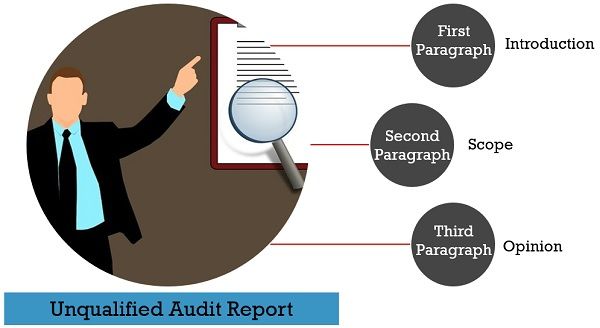
- The first paragraph of the report indicates:
- Audit work performed
- Highlights the responsibilities of the auditor and auditee, with respect to the financial statement
- The second paragraph states:
- Scope of audit work
- General Description of nature of work
- Examples of procedures performed
- Limitations faced during an audit, due to the nature of work
- The third paragraph presents:
- Auditor’s Opinion in the financial statements, i.e. whether the statements are as per the accounting principles.
Also Read: Difference Between Audit and Review
Definition of Qualified Report
A report is said to be qualified when clean chit is not given by the auditor, rather an opinion of truth and fairness of financial statements, subject to certain reservations or states anything negative. It is to be noted that the nature of the statement is such that it does not materially affect the true and fair view, that the company’s account depicts. In this way, the auditor’s report is said to be a qualified report.
When the auditor encounters any one of the two situations that are not in conformity with the GAAP, while the remaining financial statement is presented in a true and fair manner.
So, the impact of the reservations is not that relevant which can affect the truth and fairness of the entire financial statement rather it creates uncertainty with respect to certain items. Further, he expresses the nature of qualifications and the reasons for such qualifications.
Issue of Qualified Report
Situations when the auditor qualifies the report are:
- Single Deviation from GAAP: One of the areas does not adhere to the generally accepted accounting principles (GAAP), however, this does not affect the remaining financial statement from presenting a true and fair view, when taken together
- Limitations of Scope: Limitation of the scope of auditor’s work be it imposed by the client or circumstances. Due to this, the auditor could not audit one or more areas of the financial statements.
What Qualified Report contains?
- It is somewhat similar to a clean report, but with a few exceptions.
- The words used in a qualified report are quite identical to the unqualified report, however, it contains an explanatory paragraph that gives reasons for qualification after the second paragraph (the scope one) and before the third paragraph (the opinion one).
Note: Here it is to be noted that the introductory paragraph is completely similar to the one used in the unqualified report, but there is a small degree of modifications conforming to the qualifications in the explanatory paragraph.
Features of Qualified Report
A Qualified Report is characterized by: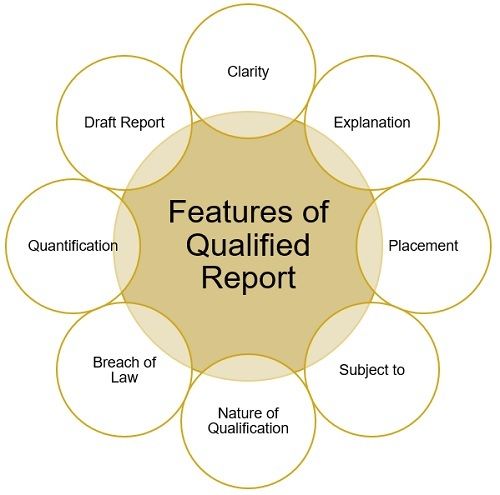
- Clarity: The nature of the qualification must be expressed in a clear and unambiguous manner by the auditor.
- Explanation: The auditor’s report shall state the reasons answering any statutory affirmation made by him either in a negative or with qualifications.
- Placement: Auditor’s report must comprise all the qualifications. In case, notes to the account are subject matter to a qualification then they should be annexed to the report. But it should be noted that a reference to the notes to account does not turn out as a qualification in the report.
- Subject to: Qualifications are preceded by the words ‘Subject to’ or ‘Except that’ to clarify that the auditor is making an exception.
- Nature of Qualification: Statements that are unclear, whose effect on the account cannot be determined should be avoided.
- Breach of Law: Any breach of law resulting from an irregularity committed by the company, should be brought to the notice of the shareholders by the auditor, with the help of qualifications.
- Quantification: Wherever possible, the auditor should quantify the effect of the qualifications made on the financial statement, when they are relevant. In case it is not possible to quantify the effect of the qualification then the effect should be indicated based on the management estimates, once the significant audit tests on the estimates are performed.
- Draft Report: To obtain the views of the management on the qualifications, the auditor may discuss the matters of qualification with the company’s management. Although, acquiring views of the management is not compulsory, but it facilitates the auditor to draft qualifications in the audit report.
Also Read: Difference Between Cost Audit and Financial Audit
Key Differences Between Unqualified Report and Qualified Report
As we have discussed the meaning of the two types of audit report, let us take a peep into the differences between qualified and unqualified reports:
- An unqualified or clean report presents that the financial statements depict the financial position, results of operations and cash flows fairly in all material aspects and adheres to the GAAP. As against, Qualified Report indicates that the financial statements depict the financial position, results of operations and cash flows fairly in all material aspects, and adheres to the GAAP besides the effect of the matter, relating to the qualification.
- An unqualified report represents that the financial statements are free from material misstatements. Conversely, a qualified report issued by the auditor when after getting sufficient audit evidence, he is of the view that misstatements are material but not pervasive.
- An unqualified report is an unmodified one, whereas any report issued other than an unqualified report is said to be modified, be it qualified, adverse, or disclaimer.
- In the case of an unqualified audit report, a clean opinion is given by the auditor, that does not have any reservations, whereas, in the case of a qualified audit report, an opinion with certain reservations is given by the auditor.
- An unqualified audit report indicates that the auditor is satisfied with the points that must be stated in his report and that too in a positive sense, without any reservations. Conversely, it reflects that there is a limitation on the scope of audit or failure of the auditee to follow GAAP.
- In the case of the unqualified audit report, there are no specific duties of management. As against, management is bound to give explanations and complete details with regard to each qualification given in the qualified audit report.
When an Auditor issues an Unqualified Report?
An unqualified report is one where the auditor does not have any objections as to the information under audit. An unqualified report is issued by the auditor when he is satisfied that: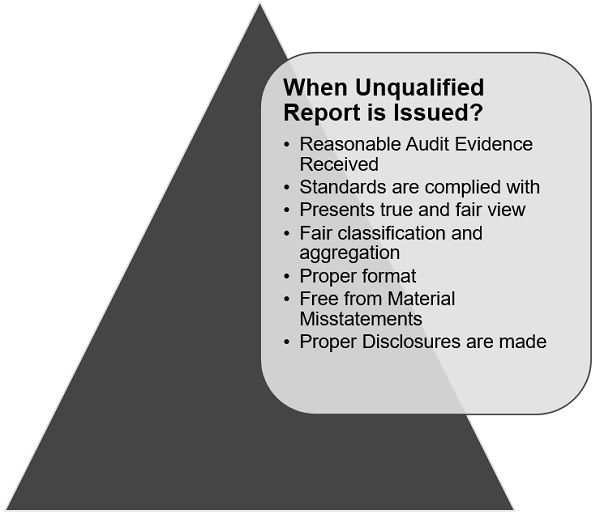
- Evidence: He has received reasonable audit evidence that supports the transactions entered in the books of accounts.
- Standard: Accounting entries made in the books of accounts are in line with the GAAP and Accounting Standards.
- True and Fair View: Financial Statements present a true and fair view of the transactions that have occurred during the course of the business.
- Classification: A fair classification and aggregation process is followed at the time of preparation of financial statements which does not conceal any material facts.
- Format: The format used for the preparation of financial statements is as prescribed by the law.
- Free from Misstatements: Material misstatements do not exist in the financial statement. Plus, none of the transactions entered in the company’s books are illegal or against the legal competence of the entity.
- Disclosure: Statutorily required disclosures are made in an appropriate manner.
Conclusion
An Audit Report is required by law, for the companies which are publicly traded. The date of the audit report is the date of the actual completion of the audit.
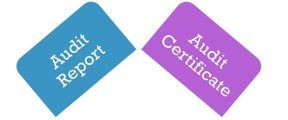





Ananya V says
Such a great article! Thank you for sharing.
Adegboyegahamid chukwebuka says
I am so glad I found this website and articles there in….good job and thumbs up
Jeminez says
Good article thank you